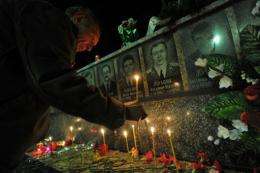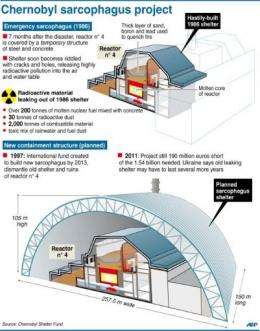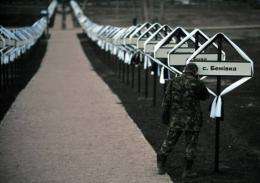World marks Chernobyl under shadow of Japan

The world on Tuesday marked a quarter century since the worst nuclear accident in history at Chernobyl in Ukraine, haunted by fears over the safety of atomic energy after the Japan earthquake.
Russian President Dmitry Medvedev is to make a landmark visit to Chernobyl later on Tuesday to take part in memorial ceremonies at the site, joined by his Ukrainian counterpart Viktor Yanukovych.
The commemorations began with a service led by Russian Orthodox Patriarch Kirill at a monument dedicated to Chernobyl clean-up workers in the Ukrainian capital Kiev in the early hours of Tuesday.
Accompanied by black-robed priests and Ukrainian Prime Minister Mykola Azarov, Kirill led a requiem for those who died after the disaster of their exposure to radiation.
A bell struck at 1:23 am (2223 GMT Monday) -- the moment when the explosion happened -- and tolled 25 times for the number of years that have passed since the disaster.
"The world had not known a catastrophe in peaceful times that could compare to what happened in Chernobyl," Kirill said, adding that the fallout from the disaster was comparable to that from the US atomic bomb dropped over Hiroshima multiplied by 500.
Medvedev, who is scheduled to arrive in the town of Chernobyl at around 0900 GMT, is set to lay flowers at the nuclear power station and attend a church service.
In the early hours of April 26, 1986, workers at the Chernobyl atomic power station in the then Soviet republic were carrying out a test on reactor four when operating errors and design flaws sparked successive explosions.
Radioactive debris landed around the reactor, creating an apocalyptic scene in the surrounding area, while material also blew into the neighbouring Soviet republics of Belarus and Russia and further into western Europe.
Two workers were killed by the explosion and 28 other rescuers and staff died of radiation exposure in the next months. Tens of thousands needed to be evacuated and fears remain of the scale of damage to people's health.
The anniversary has gained an eerily contemporary resonance after the March 11 earthquake and tsunami in Japan which damaged reactors at the Fukushima Daiichi power plant and prompted leaks of radiation.
Japan has placed the disaster on the maximum seven on an international scale of atomic crises, the same level as Chernobyl, and the troubles at Fukushima have prompted many questions about whether atomic power is too great a risk.
Moscow stayed silent on the Chernobyl disaster for three days, with the official news agency TASS only reporting an accident there on April 28, after the Forsmark nuclear plant in Sweden recorded unusually high radiation.

In 1986 and 1987, the Soviet government sent more than half a million rescue workers, known as liquidators, to clear up the power station and decontaminate the surrounding area, many not fully aware of the scale of the calamity.
"I think that our modern states must see the main lesson of what happened at Chernobyl and the most recent Japanese tragedy as the necessity to tell people the truth," Medvedev told a meeting of clean-up workers in the Kremlin on Monday.
But despite the notoriety of Chernobyl, controversy has raged for years even between the UN's own agencies over the number of deaths directly caused by the disaster, with estimates ranging from tens of thousands to just dozens.
Some experts have said the worst health legacy of Chernobyl is mental rather than physical, with those affected traumatised by the memory of April 1986, forced relocation and the sense that they are victims of nuclear catastrophe.
In 2005, several UN agencies including the World Health Organisation, said in a report a total of 4,000 people could eventually die as a result of the radiation exposure.
But the UN Scientific Committee on Atomic Radiation (UNSCEAR) says other than the 30 confirmed deaths in the immediate aftermath only 19 ARS (Acute Radiation Syndrome) survivors had died by 2006 for various reasons.
Other than 6,000 cases of thyroid cancer -- a usually treatable condition -- from contaminated milk there was "no persuasive evidence" of any other effect on the general population from radiation, it said in a report in February.

But environmental campaign group Greenpeace in 2006 accused the UN agencies of grossly underestimating the toll, saying there would be an estimated 93,000 fatal cancer cases caused by Chernobyl.
After the disaster, the Soviet authorities put up a supposedly temporary concrete shelter, dubbed the sarcophagus, to protect the destroyed reactor but there have long been worries about its durability.
A new sarcophagus is being built nearby and is scheduled to be erected over the reactor in the next years.
Chernobyl continued producing energy until well after the collapse of the Soviet Union. Reactor number two shut after a fire in 1991, reactor number one closed in 1997 but reactor number three went on working right up until December 2000.
(c) 2011 AFP



















